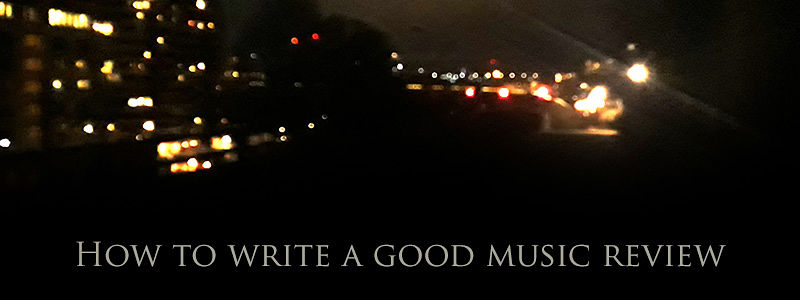
How do you write a good music review? I won’t pretend to have all the answers, but I’ve written hundreds of music reviews over the years. You can find them here, on Metal Archives or on Rateyourmusic. These are some of my tips, based on my experiences, both as a writer and a reader.
My 7 tips based on experience are:
- Have a logical structure
- Include relevant information and links in the review
- Use as many images as possible, make sure they’re up-to-date
- Focus on music description and comparisons to convey the music
- Offer unique and personal perspectives
- Listen to the album enough to know what you really think about it
- Proofread your music review properly!
About the author

I’m Stefan Nordström, an aspiring musician and content creator. This is one of the ways I promote Soliloquium, my progressive death/doom metal band. If you’re searching for new music in the style, it would be awesome if you listened to my stuff on:
Logical structure
Being a detail-oriented guy, a logical structure is probably the most important part for me. I want the review to tell a story that works for people that are new to the music, as well as existing fans. Doing the unexpected can be cool, but it really needs to convey the music to all readers, first and foremost.
Here’s a few pointers on what should be included in a music review’s structure and where it usually works best:
- Have a proper introduction about the band, its origin and history
- Describe individual favorite and least favorite songs, and why
- Don’t fall into track-by-track reviewing
- Try to be specific and not falling into non-descriptive critique. If something is “awesome” or “groovy”, explain why!
- Try to find specific instrumental parts that are interesting or could be better
- Don’t forget about the lyrics
- End on a note that conveys your overall thoughts or the grading (if you use it)
Include relevant information and links
Include things like tracklist, origin, release date and record label. Don’t forget to include links to where you can listen to the music and support the band. Embedding YouTube videos, Spotify songs or Bandcamp albums is a good way to have people listening to the music while reading the review.
All kinds of relevant info are a service to the band, the listeners and, last but not least, your music review. One good method to remember it is to have a template that includes all the important stuff. I usually copy paste a starting template to make sure I don’t miss out on something. Of course, this all highly depends on your CMS, or maybe you’re not even the one doing the actual web publishing.
Up-to-date and correct images
The album cover doesn’t need to be the only image in the review. At least not if you’re publishing on your own platform. It’s nice to get some up-to-date band pictures. Pictures are also a good way to break up long articles.
Don’t forget that the bands and labels have a lot of responsibility here too. There’s nothing that helps reviewers and other digital content publishers like a good press kit, or at least an e-mail that provides all the necessary images and info.
Musical description and comparisons
Reviews can easily lose touch and leave a listener wondering what the music actually sounds like. This is especially true for the music reviews where someone goes into the emotional and atmospheric factors a lot. Vague reviews can give the wrong expectations.
Compare the music in the review to other bands, or maybe other songs from the band being reviewed. Provide dry music description next to the more drifting side of it. Point out songs or parts of songs to make the musical description stronger.
Few things are as boring as leaving a music review without understanding what the music actually sounds like. This happens way more often than it should.
Unique and personal perspectives
Nothing in a music review is as refreshing as a unique perspective. Personal experiences and anecdotes can be one way to color a review. Another is to write a weird-ass review that still conveys the music.

stickyshooZ weird-ass review of Dismember’s “Death Metal” (sadly, you need to scroll a bit) on Metal Archives is one of those reviews. The Dismember album is actually reviewed as a hamburger, and it works!
You don’t need to go completely crazy, but unique reviews are certainly more interesting. The web has such a massive overflow or content, combined with a lack of reader attention. A unique spin can really make all the difference.
Listen to the album enough
This is an overlooked one, especially if you’re writing reviews for a zine or a website looking to get fast traffic around release dates. I know I’ve reviewed albums I’ve listened too like four times. Sometimes it works out, sometimes it doesn’t.
Some albums are growers and require a lot of listens to get there, and other albums actually fade over time. Give the music that opportunity before you publish a review. There’s no magic number, but at least five concentrated spins should be a minimum. Listening to the album while writing a music review is a good way to come across interesting talking points.
Proofread!
Obvious, but forgotten, and another casualty of the online content culture. Aside from simply looking unprofessional, language screw-ups can lead to not getting your point across. Take the time and get the spelling and overall structure right. Tell that story correctly and get the right view of the music out there.
Final words on how to write a music review
As I said, the quality of reviews online obviously suffer from tight deadlines and lack of time. Most reviewers, at least in underground zines and the like, don’t get paid and write on the side for sheer passion. The result is that, understandably, things can get rushed. Angrymetalguy is one of the coolest exceptions, writing educated, in-depth reviews with a personal touch.
Read more:
Soliloquium, Swedish progressive death/doom metal ->
How do you promote metal music online? ->
The best tips for promoting your band on Bandcamp ->
Doom metal reviews ->








0 Comments